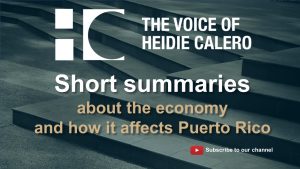


July 2016: Can PR’s Budget Adjust to the New Norm?
10 years after the government shutdown
Fiscal budgets everywhere seek to balance the basic needs of the population with the resources available to the government. In PR’s case, the fiscal challenges are even starker as meeting its current debt obligations—without any viable economic alternative to back it up—will continue to drive up migration, thus further contracting economic activity and the current tax base. In this sense, the Commonwealth is facing a dire chicken and egg problem. Stopping the population drainage will require positive economic prospects, yet to materialize. Not meeting its debt obligations will feed more uncertainty to the business community and certainly continue to deny the island access to capital markets, necessary to promote economic growth and development. All this makes it difficult to further reduce outward migration. Meanwhile, the government will need to continue to adjust its spending pattern to the prevailing socio-demographic profile of the resident population, a task easier said than done.

Q2 2016: It is Still a Long Bumpy Ride
Analysis of Puerto Rico’s 2nd Q 2016 economic indices
The goal of Compass is to provide insights on drivers of PR’s overall economy and key economic sectors with the latest financial and economic data on a quarterly basis. The 2nd Quarter of 2016 depicts an economy still in the doldrums with a negative short-term outlook. Banking, Manufacturing, and construction seem stuck in negative territory. Manufacturing keeps losing jobs, which are often middle paying, largely because of technology and worldwide weakness in China. This year’s presidential race in the US and the gubernatorial race in PR raise more issues than solutions. Start with minimum wages. US candidate Hilary Clinton supports raising the federal minimum wage to $12 an hour, up from today’s $7.25 and candidate Trump recently endorsed a rise to $10 an hour. A higher minimum wage would help some workers in the low-paying food services and accommodation industries, so long as the higher minimum did not destroy their jobs by making it unprofitable to employ them. On the local front, the expected US fiscal control board has done little to halt the island’s mood of uncertainty.

May 2015: Sharing the Pain with Debtors
Analysis of recommended PR fiscal budget in FY 2017
With total public debt of around 101% of GNP in FY2016, an extremely high figure for Puerto Rico, the question is not whether the government should cut its budget deficit but by how much and how to cut wisely. To bond markets’ consternation, Governor Alejandro García Padilla announced to the world last year the island could not pay its public debt and would likely default on its debt service payments. Fiscal policy must be driven by reason, responsible policymaking, and cost-benefit-based analysis of government’s spending priorities. After 10 years, PR’s economic growth is still negative; private and public investment is at its nadir; retired public workers expect full pensions and reliable health coverage; and US Congress threatens to impose a unilateral Fiscal Control Board to regain fiscal discipline and ensure public debt is paid. Will the recommended budget protect Puerto Ricans from various risks: unemployment, destitution, illness, and lack of education? What will it take to recover a growth path in the island?

April 2016: PR Stretched to the Limit
Review of Global, US & PR economies in FY 2015 plus forecasts from 2016 to 2018
The past few weeks have seen an unprecedented spike in uncertainty over the Island’s long-term prospects. The combination of a pending default on public debt, political wrangling both in Washington and San Juan, and continuous negative news about the economy has opened the door to short-term politics and the prospects of a full-blown crisis. Ultimately, the economy will adjust to the existing reality on the ground however unpleasant this may be with the real test only just beginning. The policy and institutional framework will have to be rebuilt pretty much from scratch as constrained budgets, lower economic activity, lower population, and impoverished consumers are here to stay, at least for a while. Striking the right balance will require a significant amount of creativity and courage but the alternative is definitely more daunting. Coming to grips with the hard facts that public debt is a debt we all must pay is only the beginning. What will it take to chart a path to solvency and growth in PR?

March 2016: A Clear and Present Danger
Analysis of the proposed Federal Oversight Board for PR
Chairman Rob Bishop of the US House Committee on Natural Resources submitted a draft bill on March 29, 2016 to “establish an Oversight Board to assist the Government of PR, including its instrumentalities, in managing its public finances, and for other purposes.” The bill grants broad powers to a 5 member Board, charged with the task of proposing necessary reforms to solve PR’s fiscal crisis. It will audit the central government and its corporations; create efficiencies, and reforms with transparent fiscal plans and balanced budgets while improving services; and facilitate a court supervised debt restructuring if voluntary agreements are not achieved (but not under the umbrella of Chapter 9 since that would imply “a bailout of PR on the backs of US taxpayers”.) Why does PR need a fiscal board? Will the Board be subject to the claims of numerous bondholders all requesting priority in their debt payments? Or, will it be accompanied by a package of federal assistance to stabilize the Commonwealth’s liquidity problems and set out a roadmap for economic growth?
Q1 2016: Uphill All the Way in Puerto Rico
An analysis of 1st. Quarter 2016 economic indices
Puerto Rico is now in its tenth year of economic recession, which it started in 2006. The fiscal crisis, which has played center stage in the past administrations, has been defined by a failure to provide effective governance and leadership in response to serious economic challenges. The fiscal crisis has not gone away and the harsh tax increases have been compounded by a migration crisis. Q1 in 2016 was plagued with uncertainty, fueled by: government’s inability to pay its public debt, suppliers, reimbursements to taxpayers, fear of job losses at GDB, poor retail sales performance, and an unsympathetic US Congress intent on enforcing a Fiscal Control Board over Puerto Rico with unknown implications. Among all these uncertainties, only one thing is certain: the future will be uphill all the way and at significant political and economic cost. This issue examines the performance of our six quarterly indices, which depict an economy in trouble.

January 2016: China’s Foothold in Latin America & Caribbean
Where and what are China’s investments
Since 1980, China’s economic policy was to become one of the top three economies in the world. As of 2015, China ranked second in GDP with an $11.4 trillion economy, behind the $18 trillion US GDP. Although the Chinese economy currently faces the onset of a permanent slowdown (5% today compared with its past double-digit real economic growth), that still represents more economic output than in 2007. And because the Chinese economy is so much larger now, we have seen growing amounts of investment flowing from China into Latin America and the Caribbean (LAC). Most of these investments have been in infrastructure and undertaken by Chinese state-owned firms. How much have they invested in LAC? Is the Caribbean soon to become a beachhead for China? China is now moving its economy from export and investment-led growth to domestic consumption and service-led sectors. Will this change represent positive or negative effects for the global economy, and for LAC in particular? Jamaica, Trinidad, Nicaragua, and Peru, among others, have benefitted from Chinese investments, then why not Puerto Rico?

December 2015: What if Questions for the PR Economy
Great expectations amidst irreconcilable conflicts
As 2015 nears its end and a new year is about to start, it is time for reflection. The fundamental structure of the PR economy is changing. While the contribution of services to output is on the rise, investment and productivity remain flat or even declining, wealth is not accumulating, and growth and inflation continue declining. Meanwhile, globalization has increased co-dependence in the global economy: a rising number of countries can influence the world’s economic performance and its financial stability. With no investment nor prevention of outward migration, the PR economy is in the middle of a “lost decade”. Puerto Rico struggles with slow to negative growth, a sizeable external debt, capital outflows and lack of badly needed investment. Unfavorable demographics, inflexible labor markets, and a rising outward migration pose the biggest threats to our economy. The shortcut to recovery requires orderly debt restructuring and investments faster than expected. The PR economy is weak with a continued trade-off between sustained growth and debt deflation spiral. What will it take for PR to regain economic growth? What if…?

Q4 2015: No End Yet for PR’s Fiscal Crisis
How this impacts 4Q-2015 economic indicators
Several bold events occurred this quarter in Puerto Rico and the US. In October, the US Department of Treasury presented a Roadmap for Congressional Action, suggesting key measures to deal with PR’s fiscal crisis. At the end of the year and after several public hearings, Congress could not reach an agreement regarding Chapter 9, a federal fiscal control board, Medicaid funds parity for PR or other lifesavers such as the Earned Income Tax Credit or a Child Tax Credit for Puerto Rican households. Locally, the administration was dealing with liquidity strains and submitted several proposals to solve the problem. However, it appears that without federal assistance, the internal actions will fall short. The net effect of this situation is widespread pessimism and uncertainty. This current issue analyzes how these events have impacted economic indicators during 4Q 2015 and what to expect in the near future.







